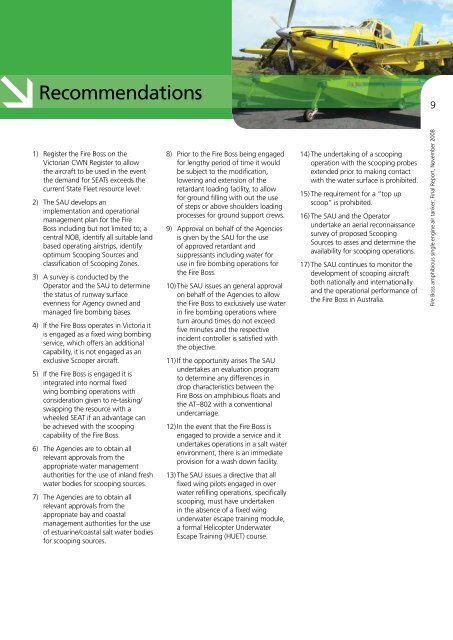Fire Boss amphibious single engine air tanker: - Department of ...
Fire Boss amphibious single engine air tanker: - Department of ...
Fire Boss amphibious single engine air tanker: - Department of ...
Create successful ePaper yourself
Turn your PDF publications into a flip-book with our unique Google optimized e-Paper software.
Recommendations<br />
1) Register the <strong>Fire</strong> <strong>Boss</strong> on the<br />
Victorian CWN Register to allow<br />
the <strong>air</strong>craft to be used in the event<br />
the demand for SEATs exceeds the<br />
current State Fleet resource level.<br />
2) The SAU develops an<br />
implementation and operational<br />
management plan for the <strong>Fire</strong><br />
<strong>Boss</strong> including but not limited to; a<br />
central NOB, identify all suitable land<br />
based operating <strong>air</strong>strips, identify<br />
optimum Scooping Sources and<br />
classification <strong>of</strong> Scooping Zones.<br />
3) A survey is conducted by the<br />
Operator and the SAU to determine<br />
the status <strong>of</strong> runway surface<br />
evenness for Agency owned and<br />
managed fire bombing bases.<br />
4) If the <strong>Fire</strong> <strong>Boss</strong> operates in Victoria it<br />
is engaged as a fixed wing bombing<br />
service, which <strong>of</strong>fers an additional<br />
capability, it is not engaged as an<br />
exclusive Scooper <strong>air</strong>craft.<br />
5) If the <strong>Fire</strong> <strong>Boss</strong> is engaged it is<br />
integrated into normal fixed<br />
wing bombing operations with<br />
consideration given to re-tasking/<br />
swapping the resource with a<br />
wheeled SEAT if an advantage can<br />
be achieved with the scooping<br />
capability <strong>of</strong> the <strong>Fire</strong> <strong>Boss</strong>.<br />
6) The Agencies are to obtain all<br />
relevant approvals from the<br />
appropriate water management<br />
authorities for the use <strong>of</strong> inland fresh<br />
water bodies for scooping sources.<br />
7) The Agencies are to obtain all<br />
relevant approvals from the<br />
appropriate bay and coastal<br />
management authorities for the use<br />
<strong>of</strong> estuarine/coastal salt water bodies<br />
for scooping sources.<br />
8) Prior to the <strong>Fire</strong> <strong>Boss</strong> being engaged<br />
for lengthy period <strong>of</strong> time it would<br />
be subject to the modification,<br />
lowering and extension <strong>of</strong> the<br />
retardant loading facility, to allow<br />
for ground filling with out the use<br />
<strong>of</strong> steps or above shoulders loading<br />
processes for ground support crews.<br />
9) Approval on behalf <strong>of</strong> the Agencies<br />
is given by the SAU for the use<br />
<strong>of</strong> approved retardant and<br />
suppressants including water for<br />
use in fire bombing operations for<br />
the <strong>Fire</strong> <strong>Boss</strong>.<br />
10) The SAU issues an general approval<br />
on behalf <strong>of</strong> the Agencies to allow<br />
the <strong>Fire</strong> <strong>Boss</strong> to exclusively use water<br />
in fire bombing operations where<br />
turn around times do not exceed<br />
five minutes and the respective<br />
incident controller is satisfied with<br />
the objective.<br />
11) If the opportunity arises The SAU<br />
undertakes an evaluation program<br />
to determine any differences in<br />
drop characteristics between the<br />
<strong>Fire</strong> <strong>Boss</strong> on <strong>amphibious</strong> floats and<br />
the AT–802 with a conventional<br />
undercarriage.<br />
12) In the event that the <strong>Fire</strong> <strong>Boss</strong> is<br />
engaged to provide a service and it<br />
undertakes operations in a salt water<br />
environment, there is an immediate<br />
provision for a wash down facility.<br />
13) The SAU issues a directive that all<br />
fixed wing pilots engaged in over<br />
water refilling operations, specifically<br />
scooping, must have undertaken<br />
in the absence <strong>of</strong> a fixed wing<br />
underwater escape training module,<br />
a formal Helicopter Underwater<br />
Escape Training (HUET) course.<br />
14) The undertaking <strong>of</strong> a scooping<br />
operation with the scooping probes<br />
extended prior to making contact<br />
with the water surface is prohibited.<br />
15) The requirement for a “top up<br />
scoop” is prohibited.<br />
16) The SAU and the Operator<br />
undertake an aerial reconnaissance<br />
survey <strong>of</strong> proposed Scooping<br />
Sources to asses and determine the<br />
availability for scooping operations.<br />
17) The SAU continues to monitor the<br />
development <strong>of</strong> scooping <strong>air</strong>craft<br />
both nationally and internationally<br />
and the operational performance <strong>of</strong><br />
the <strong>Fire</strong> <strong>Boss</strong> in Australia.<br />
9<br />
<strong>Fire</strong> <strong>Boss</strong> <strong>amphibious</strong> <strong>single</strong> <strong>engine</strong> <strong>air</strong> <strong>tanker</strong>: Final Report, November 2008





![Metcalfe State Forest Fauna Species List [PDF File - 16.9 KB]](https://img.yumpu.com/22024301/1/184x260/metcalfe-state-forest-fauna-species-list-pdf-file-169-kb.jpg?quality=85)






![PPE Price List for Wildlife Volunteers [PDF File - 20.3 KB]](https://img.yumpu.com/15321634/1/190x135/ppe-price-list-for-wildlife-volunteers-pdf-file-203-kb.jpg?quality=85)




